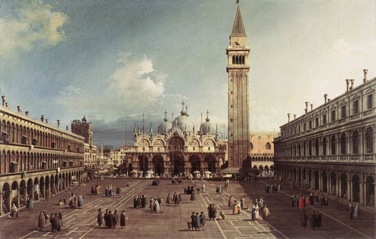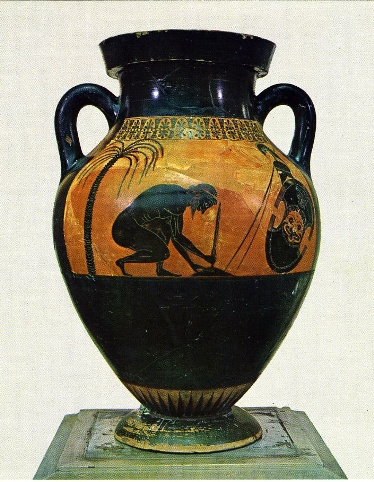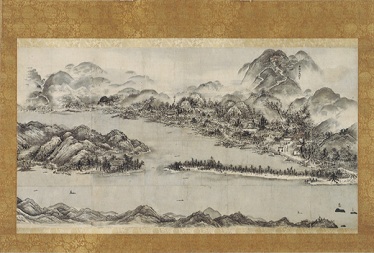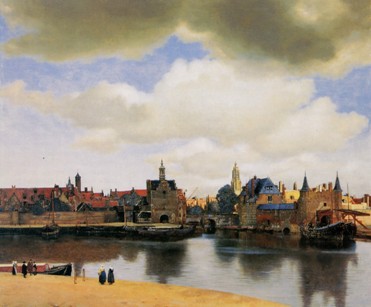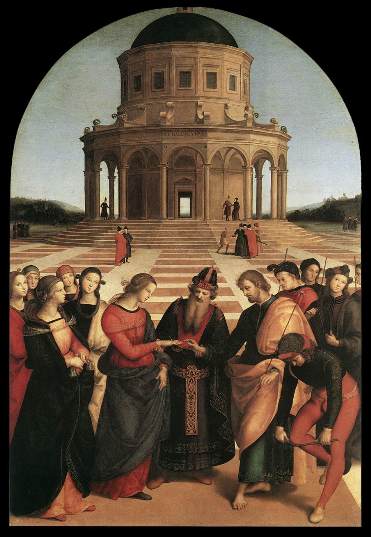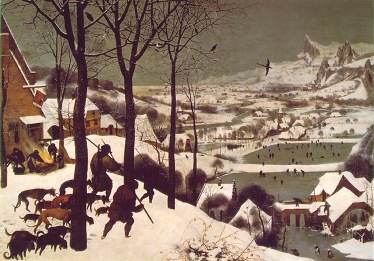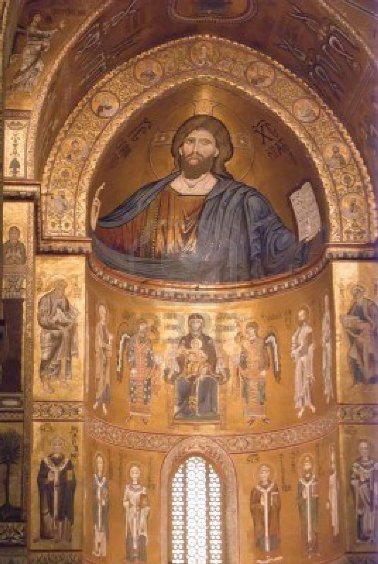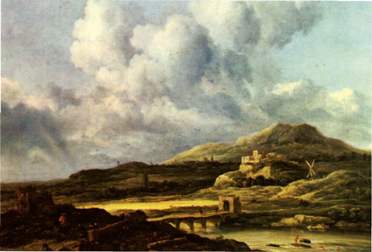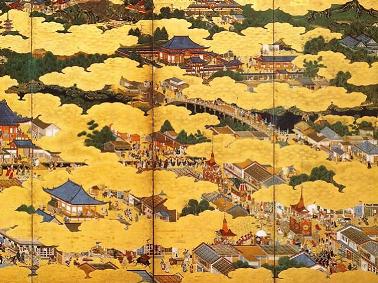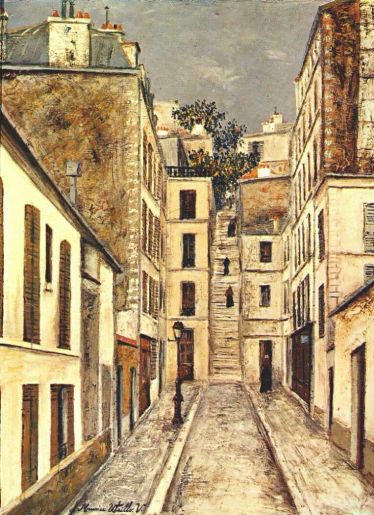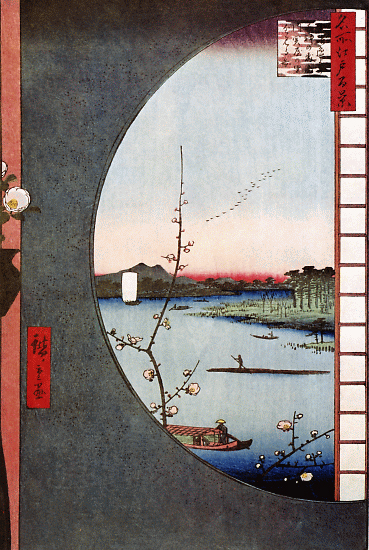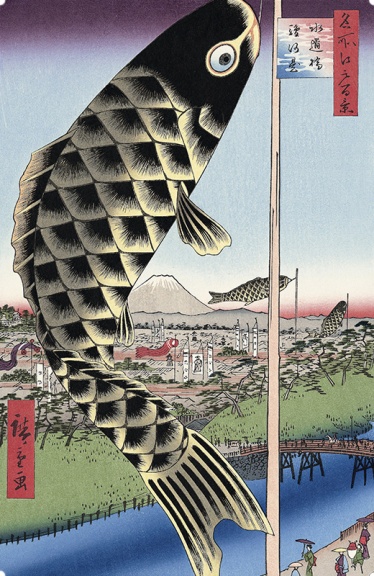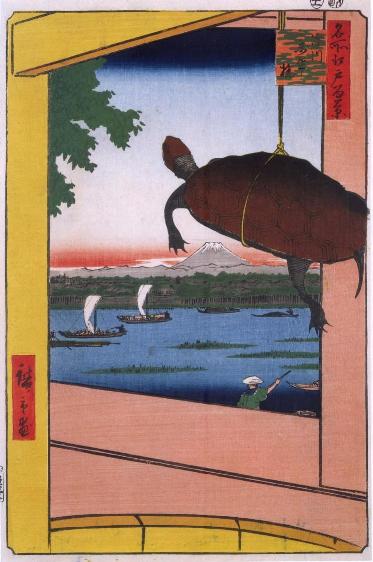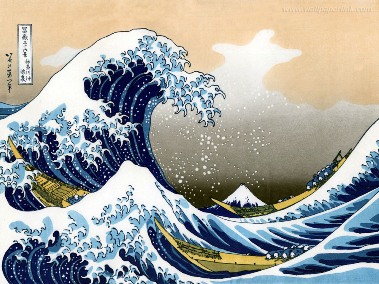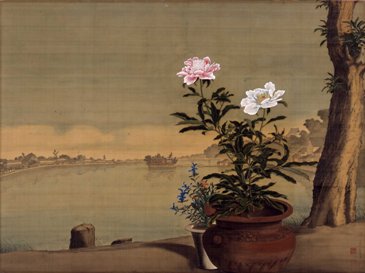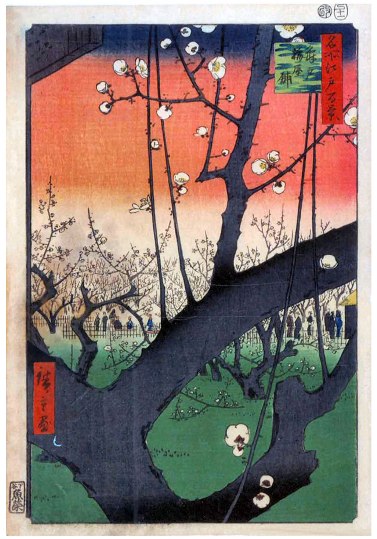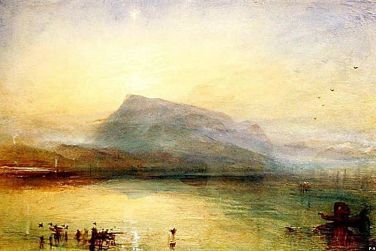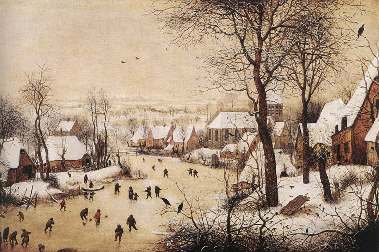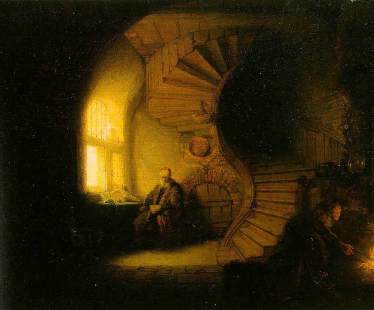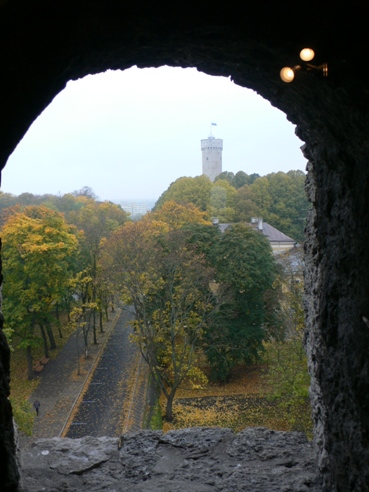Perspectives East and West
Skip other details (including permanent urls, DOI, citation information): This work is licensed under a Creative Commons Attribution-NonCommercial-NoDerivatives 3.0 License. Please contact [email protected] to use this work in a way not covered by the license.
For more information, read Michigan Publishing's access and usage policy.
To Heinz, in memory of the precious time we shared.
Abstract
The object of this paper is to elucidate the sense of space peculiar to Japanese sensibility. To accomplish this task I consult not only paintings but also waka, distinctively Japanese poetry. I also compare the structures of Japanese and Western perspective in order to highlight the distinctive features of the Japanese sense of space. In China and Japan, traditional landscape painting was called sansui painting, literally, painting of "mountains and waters," unlike fūkei painting, which is a modern adaptation of the Western notion of landscape. Landscape as sansui is characterized by its vitalistic conception: the cosmic space is filled with ki, a vital and spiritual element. This view is reflected in the Japanese notion of keshiki (literally, color of ki), another word meaning landscape, to which I pay particular attention because it is a vernacular word and expresses the genuine Japanese sense of space, differentiated even from the Chinese perspective found in Sansui paintings. Such a space as keshiki was to be felt rather than seen. The notion of the picturesque was associated in Japan with a spatial extent. It is a concept closely related to a humid climate that produces much fog or haze. A typical description is found in the Tale of Genji.
It is in waka,from the thirteenth century, that we find the first expression of Japanese perspective, which consists the combination of a tactile, sometimes auditory close range with the visual, distant range, yet without a middle range (which is obscured by fog). This is very different from Western geometrical perspective, which is essentially constituted by the middle range relating the close continuously to the distant. In painting, this Japanese perspective was realized for the first time in ukiyo-e, particularly in the work of Hokusai and Hiroshige. I assume that this composition was transplanted to the Western world during the fashion for "japonisme," and now determines the basic composition of the landscape photograph.
Key words
East/West, Japanese culture, perspective, sense of space, tactility, ukiyo-e
1. Perspective and the sense of space
The word ‘perspective’ in my title means, first, literally an expansive view perceived visually, and second, the technical term in painting for the formula for depicting such a view. In both cases it concerns a form of the sense of space. By the title "perspective East and West," I mean that this form of spatial sense is differently conceived in at least two types. I’ll concentrate more on the East, the Japanese in particular, than the West, and more on the sense of spatial perception than on perspective as a pictorial technique. To be more precise, my subject here is the sense of space peculiar to Japanese sensibility, which is not only expressed in paintings and drawings, but also determines and structures our perception of the world and representations of places where we are. In other words, it concerns the underlying aesthetic principle according to which we look over an expanse of land, find a space agreeable, and determine the angle and plan in taking a photograph.
I will refer to Western perspective in order to make salient the features of the Japanese sense of space. By Western, I understand the geometrical perspective, established during the Renaissance. The widespread distribution of photographic images has saturated contemporary Japanese culture with this perspective so that it is necessary to contrast it with the prototype of the Japanese sense of space, which is our concern here. So the contribution of this study will lie in digging up the archaic layer of this sense of space and comparing it to the current one. To avoid misunderstanding, I would like to mention that not all photo images display Renaissance perspective. That perspective consists in being drawn geometrically, and choosing its objects, which should themselves be geometrical and contain straight lines.
Cityscapes, such as painted by Canaletto (illus. 1), and ceilings with beams and floors set with tiles, such as seen in a Vermeer (illus. 2), are appropriate for this perspective.
This is why it is called "linear perspective." In other words, it is a manifestation of city culture, and it is almost impossible and nonsensical to draw a natural landscape in such a perspective.
According to Panofsky, who wrote a classical study on geometrical perspective, a pictorial surface constructed on this principle loses its original materiality and becomes a simple "picture plane" on which is projected "the spatial continuum […] which is understood to contain all the various individual objects" and which is "infinite, unchanging and homogeneous space."[1] So this space in which all objects are situated is the basic condition of perspective. Panofsky contrasts it with the ancient concept of space based on three-dimensional corporality. When they combined some objects, ancient people laid them out "in a kind of tectonic or plastic cluster."[2] We can mention, as an example, the black painting on an amphora by Exekias (sixth century B.C.E.) of the hero Ajax, who commits suicide (illus. 3).
The hero is preparing the suicide and his arms and the bent palm tree are depicted separately without regard to their respective relationship of size and place. Here there is no perspective.
The full-scale absorption of Western geometrical perspective in Japan began at the end of the eighteenth century by Kōkan Shiba (1747-1818). Prior to that, it had been used in ukiyoe in order to produce an effect of depth, and because of such a striking effect, those pieces were called uki-e, literally, painting of relief.[3] The fact that they gave a particular name to this new technique reflects how different Western perspective was from Japanese painting. My task here consists in explaining this feeling of difference. As for the contrast of Eastern and Western perspective, I am giving the Eastern a literal and less technical meaning. It concerns the composition of an image representing a space in which every object is situated according to a scale of distance, near or far. You can see that in the mono-chrome painting of Amano-hashidate (illus. 4) by Sesshū (1420-1506).
Even though it is not genuinely geometrical, it can be regarded as perspective because it represents a total space encompassing all the objects.
As stated at the beginning, my subject here is not perspective as a technique but rather the sense of space that supports such a technique. That sense of space consists mainly but not exclusively in vision. The other four senses, particularly the sense of touch, or more exactly the bodily sense belonging to the whole body, play an important role, for the space is felt rather than seen. Besides, intellect takes an important part in it. As far as human sensibility is concerned, even the sense organs do not work without intellect, and we know that our feeling becomes more mature with the growth of our intellect. A painting or a drawing looks like a simple visual plane, but when we look at it as a painting or drawing, our sensibility as a synthesizing perceptual faculty is at work.
Accordingly, in order to consider this sense of space, I want to consult not only painting but also, and even more, waka, a short form of Japanese poetry. In contrast with Chinese poetry, which was practiced in public contexts in all East Asian countries outside of China, including Japan, waka, meaning "Japanese poetry," was chanted to express private experiences and feelings. The prototype of our present sensibility was formed in ancient to medieval times (between the seventh and fifteenth centuries), early periods from which we have no legacy of painting. We should also take into account the specific relationship between waka and paintings during late ancient times, for paintings were often made of the scenery evoked by waka, and afterwards a waka genre was established that consisted in a depiction of pictorial scenery.[4] Therefore waka should be consulted not simply for convenience. It is particularly important to recognize that painting is not necessarily the best mediuim for the study of the sense of space. Since language has the advantage of articulating and relatingin a precise way the material position of things in a space, waka provide valuable documents.
2. Landscape and sansui
As suggested by Panofsky,[5] the pictorial representation of such a space was developed especially through landscape painting. Yet we don’t call the painting by Sesshū fūkei-ga (landscape) but rather sansui-ga (shanshui-hua in Chinese). Sansui means literally "mountains and waters," i.e. nature. The name of fūkei-ga was invented at the middle of the nineteenth century in order to translate the Western term ‘landscape painting.’ It was this feeling of difference, mentioned earlier, produced by the Western style that required a new name: ukie. Before then, paintings representing landscape had been called sansui-ga. But those in the new Western style appeared to be so different from them that people needed a different name.
In English, the word ‘landscape’ means both the features of the land itself and the painting of such scenery. This ambiguity reflects the Western sense of landscape that focuses on its visual aspect. As the result, the suffix ‘-scape’ is almost confused with ‘scope’ in words such as ‘landscape,’ ‘cityscape,’ and ‘seascape.’ More important here is the word ‘land.’ Sansui is a kind of ‘land,’ but land is not limited to mountains and waters.
The views of Venice by Antonio Canaletto, those of Dresden by his nephew Bernardo Belotto (illus. 5), and the view of Delft by Vermeer (illus. 6) are landscapes but don’t consist of mountains and waters.
Here we find the fundamental difference between sansui-ga and landscape paintings. If we exclude cityscape from its range, landscape would lose its privileged relationship with perspective proposed by Panofsky.
In order to explain this difference between landscape and sansui, I wish to consult an image, once considered as representing the ideal city and attributed to Piero della Francesa (illus. 7).
The ideal city is the geometrical city plan proposed by several architects and painters during the Renaissance following the rediscovery of Platonism. We can hardly explain the reason why the painter depicted the visual aspect of an ideal city like this, so it is now regarded as a study of a background for historical paintings. Comparing the Marriage of the Virgin by Raphael (illus. 8) with this, we perceive the manner of composition by using a background prepared separately.
This manner signifies that in modern Western paintings, either a natural landscape or an urban landscape was introduced as the scenery in which human activities should be portrayed. This conception is tightly linked to the hierarchy of genres that takes historical paintings as the paradigm and represents the anthropocentrism that would dominate modern Western civilization. A Breughel could depict people’s lives in nature (illus. 9) because that was the human life he knew and with which he had deep sympathy; what is found in the background of Raphael’s image is urban civilization confined to the intra-mural area.
In both cases, we find a clear consciousness of the space enveloping human life, which should be contrasted with the Kunstwollen representing just the image of a saint or a king (illus.10).
This space consciousness will be developed into the landscape of nature of a Ruysdael (illus. 11) and the townscape of a Canaletto.
Even if there were no human figures in the natural image and people were fused with the street scenery, man still plays the leading part because it is his gaze requesting the landscape paintings that dominates the whole phenomenon. Moreover, the increasing popularity of landscape painting, including townscapes, must be related to the development of tourism. The paintings of this genre offered a variety of sights people wanted to visit. The gaze that dominates such scenes coincides in its principle with geometrical perspective that, as mentioned above, is peculiar to urban culture and thus shares the ideal in modern Western civilization of conquering nature.
Sansui, or "mountains and waters," is very different from landscape. In the first place, as suggested above, we cannot apply this word to townscapes. In addition, a desert cannot be called sansui since this requires a humid climate. More essentially, what is decisive is the cultural connotation peculiar to this word. The Great Dictionary of Japanese, after giving the literal meaning in the entry on this word, adds the following second meaning: this word, "derived from the geographical features of mountains and waters, can mean the natural world in general, in contrast with the common human world."[6]
The contrast tothe secular world relates sansui to retirement. We remember the Christian hermits who retired to a desert. Sansui and desert are completely different. Desert is nothingness and erases the secular world, so much so that hermits are haunted by phantoms. We see this, for example, in the famous painting of St. Antonius’ Temptation by Hieronymus Bosch (illus. 12).
Being placed in an annihilated environment, a hermit who has lost his world cannot but live only with himself, so that the desires, fears, worries, etc. about himself seem to appear in exaggerated and distorted forms. We cannot conceive such a thing in a retired life in sansui because sansui is not nothingness of the world but rather constitutes a different world. The development of sansui painting in China is considered linked to the philosophy of shinsen (shen xianin Chinese), which aims at attaining the transcendental state of immortality. Sansui was the place of training for identification with tao, the principle of being, in view of the highest state. Indeed, in sansui painting, we find human figures: a fisherman on a lonely boat, a man following a mountain path, a man meditating in a cottage, etc. Here the relationship between man and the world is the reverse of the case of a Raphael or a Breughel. Sansui is not the background of human actions and historical events but the unique or holy place that enables man to transcend: nature comes first and man follows. In the fifth century Chinese theory of painting called liufa (six principles), it was the vibration with vital power of ki (qiyun shendong in Chinese) that was considered most important, far above the exactness of representation, coloring, and imitation of classics, etc. This notion can be applied only to sansui painting. Sansui painting must realize this because sansui is a live space, full of ki. Thanks to such a sense of space, sansui painting could presentperspective in its literal sense.
3. Keshiki and Fūkei
Compared with traditional sansui painting, the Western style of landscape in geometrical perspective appeared to be so different that people invented the new word fūkei-ga, meaning literally "landscape painting," the term we use today. To designate an actual landscape, we have another word, ‘keshiki,’ and we use both fūkei and keshiki almost interchangeably. Very few people can probably tell the difference between them. But as we call the Western landscape painting fūkei-ga and never keshiki-ga, there must be a reason. Their difference, in my opinion, lies not in the meaning but in the contexts in which each word is used. Both are constituted with two Chinese characters and are derived from Chinese words. But we have a striking fact that in the twenty-one royal anthologies of waka (905-1439), we find as vocable only keshiki. This means that the word fūkei was never used in waka, i.e. in purely Japanese poetry, and that whereas fūkei was accepted as a Chinese word, keshiki was considered Japanese. So fūkei was considered suitable for translating the Western word ‘landscape.’
Since I would like to elucidate the sense of space peculiar to Japanese sensibility, I shall give attention neither to sansui, the Chinese concept of landscape, nor to fūkei, the word derived from Chinese, but to keshiki, the Japanese concept of landscape. Referring to waka, I want to look for the primitive perception of landscape and its style in Japan. As keshiki was originally written with two Chinese characters, meaning "color or tone of ki," it is clear that the Japanese concept of keshiki shares the notion of ki, the vital element filling space. In the midst of natural space, people corresponded with the universal ki. Such an aesthetic experience of nature was chanted by Yamanoue-no Okura (660-733?):
Ohno-yama kiri tachiwataru, waga nageku
(Mount Ohno, fog begins to form and envelop, I grieve)
okiso-no kaze-ni kiri tachiwataru
(and because of my sigh, fog begins to form and envelop.)
The poet has lost his wife and buried her in Mount Ohno.[7] Ancient people believed that their sigh transformed itself into fog, so our poet chants that the fog enveloping Mount Ohno is his grieving sigh. We find here the experience of natural landscape of someone who merges into and corresponds with nature, ‘correspond’ in the sense Baudelaire gave it.
The word keshiki itself is used neither in this piece nor in the whole anthology containing it. The earliest examples of this word date from the tenth century in prose and the eleventh century in waka. We must pay attention to the fact that they were in such phrases as fū-un-no keshiki and sora-no keshiki (keshiki of winds and clouds, and that of the sky). Keshiki in these phrases means neither sansui nor landscape as an object of contemplation but an‘indication,’‘air,' or 'feeling,' and accords with its literal meaning, that is, "color of ki." This fact strongly suggests that the original meaning should dominate its later use in waka in the way that vis-à-vis natural scenery filled with ki, the ancient people must rather feel its color than look at it. Let us consult a waka by Suemichi Fujiwara (the first half of the twelfth century):
Sae-wataru yoha-no keshiki-ni miyamabe-no
(Through this extensively cleared keshiki of night, in the deep mountains)
Yuki-no fukasa-wo sora-ni shiru-kana
(I sense the depth of snow.)
The keshiki described as being "extensively cleared" must refer to the night sky. The subtle point of this concept is found in the fact that the poet speaks simply of the "keshiki of night" without mentioning the substance (the sky). Perceiving the modality of a being without noticing its substance is typically aesthetic. Indeed, our poet gives no further description of this keshiki but surmises in it "the depth of snow in the deep mountains," from which we can think back to a visual image of the "keshiki of night." It is an empty extent of the sky, without any clouds and filled with bluish light of an extremely cold moon. The aesthetically perceived aspect of this space is keshiki. When the poet succeeds in giving a proper expression of this aesthetic aspect, we can form a visual image of it. But keshiki itself is not a visual image. The great poet Saigyō (1118-90) liked the expression "keshiki of wind." Likewise, we have "keshiki of the world"[8] in the following piece by Princess Shokushi (1149-1201):
Ima sakura sakinu-to miete usu-gumori
(The cherry seems to have blossomed now; it is slightly cloudy,)
haru-ni kasumeru yo-no keshiki-kana
(the keshiki of the world is misty with spring.)
As she says, "the cherry seems to have blossomed," she does not look at the blossoms, the most typical object of spring in Japan. Our poet perceives only the atmosphere of spring hanging in the air. This vague spreading atmosphere is keshiki.
4. Keshiki and watari
Through this discussion we recognize that keshiki refers to a spatial extent and lies in its aesthetic quality. A sansui painting full of "the vibration with vital power of ki (qiyun shendong)" is not a landscape but a keshiki in this sense. Yet since keshiki is a spatial extent to be felt, the pieces of waka we have analyzed so far do not offer any perspective because there is no fixed viewpoint. There is no perspective in an "extensively cleared night sky" and the spring atmosphere making everything misty. That is to say that although we perceive keshiki from time to time visually, keshiki itself does not imply the visual or the picturesque, unlike the contemporary use of this word.
However, we should not neglect the historical fact that this word should be confined to its current use, meaning 'landscape.' Even in ancient times, keshiki as "the color of ki" must have been perceived especially in visual scenery. When a viewpoint was fixed, the whole extent of space could display a perspective structure. I think it was the concept of watari that contributed to that effect. Indeed, watari used in Suemichi’s waka as sae-wataru expresses the extent of space. As soon as keshiki was chanted in waka, it seems to have been linked to the concept of watari. We can recognize this in the famous piece by Nōin-hōshi (988 - after 1050):[9]
Kokoro aram hito-ni misebaya Tsu-no kuni-no
(I wish to show a man of good taste, of Tsu district)
Naniwa watari-no haru-no keshiki-wo
(keshiki of spring around Naniwa.) (Anthology Goshūi, No.43)
Its short introduction says that the poet was in Naniwa region around New Year’s Day and sent this piece to his friend: it is a simple waka of correspondence. Naniwa watari in this piece means "around Naniwa," but that space is full of the movement peculiar to watari. Wataru (verbal form of the noun watari) means to go across and over to the opposite side, so it implies starting and arrival points. When we say "mi-watasu" (mi means to see and watasu is the transitive form of wataru), the starting point of the movement of seeing is naturally my viewpoint and the arrival point is far in the distance. We find here an elementary form of perspective. Wataru is also projected on the temporal phase to add a sememe of duration or continuation, such as koi-wataru meaning "to love forever" or machi-wataru "to wait for a long time." I also notice a feeling of aspiration, the wish to send love to one’s lover far away, that is implied in the expression of koi-wataru,. This expression must also imply dramatic transition between hope and despair in its temporal phase, just like mi-watasu implies the movement of a scanning eye on the space. You might note that when we say the night sky sae-wataru, i.e. a clear extent, it is the overall character of the sky that is talked about. Indeed there is no movement in the sky but, hearing such an expression, we are immediately conscious of the movement of our eye as the reader who is looking up at the night sky. For watari implies movement as its essential element and needs a subject making that movement.
In short, watari implies both the movement of the eye looking and a spatial extent as its object. Consequently, hearing the phrase "keshiki of spring around Naniwa (Naniwa watari)," even though nothing is described, we get a visual image of seashore scenery, mild, peaceful, and rather warm.
5. Skipping the middle range
We have thus recognized that keshiki as 'color of ki’ is a cosmic extent full of vital energy ki and implies perspective from my position looking over that extent. This perspective, however, is still not articulated, and in this regard the case is similar to "keshiki of spring around Naniwa" and "the cleared up night sky." Now let us read some pieces that show this. They all date from medieval times, i.e. after the thirteenth century, and suggest the development or maturation of the sense of space. The following is a piece by Eifuku-mon’in (1271-1342):
Tsukikage-ha mori-no kozue-ni katabukite
(The moon is declining onto the tree tops of forest,)
Usuyuki shiroshi ariake-no niwa
(Thin snow covers white the garden at dawn.)
In the distance we see the moon declining above the black silhouette of the forest, while at close range, the garden is covered with white snow. The scenery is constituted from a distant and a close range view. I quote another two pieces by the same poetess. The first one is as follows:
Sayo fukaki, nokiba-no mine-ni tsuki-ha irite
(The night going on, the moon enters over the hilltop on the edge of the eaves,)
Kuraki hibara-ni arashi-wozo kiku
(I hear the wind on the dark forest of cypress.)
This piece presents the same scenery structure and the only difference from the one quoted above is that the close range is auditory instead of visual. "Nokiba-no mine" (the hilltop on the edge of the eaves) is an interesting expression: the poetess stays in a room of the palace and looks out through an open casement window. In this situation the distant mountains are seen on the edge of the eaves. The distant is caught, so to speak, in terms of what is nearby. Moreover, she adds an auditory perception at close range. From her position, she cannot see what is close by outside and perceives it through the blowing wind. We find several similar examples of such a scenery structure in waka by Eifuku-mon’in and some other poets.
The striking characteristic of this scenery consists in the fact that there are only close and distant ranges with the middle one lacking. In the following piece, mist fills the middle range but that is, so to say, empty.
Ochi-kochi-no yama-ha sakura-no hana-zakari
(Mountains here and there are full of cherry blossoms,)
nobe-ha kasumi-ni uguisu-no koe
(in the field are mist and the song of the bush warbler.)
I recognize here a pictorial expression dear to Japanese paintings. Let me quote from the Tale of Genji, anovel dating from the very beginning of the eleventh century. Suffering an illness, Genji, the hero of the novel, visited a sage in the northern hills of the capital district. After giving him medicine and curing him, the sage advised Genji not to worry too much. Then
Genji climbed the hill behind the temple and looked off toward the city. The forest had receded into a spring haze. "Like a painting," he said. "People who live in such a place can hardly have anything to worry about." "Oh, the ‘keshiki’ around here is not profound enough," said one of his men. "The mountains and seas in the far province should help you gain real progress in your painting"…[10]
The landscape qualified here as being "like a painting" is the scenery with tree tops perceived here and there through the veil of haze. Because they are not thought to be so profound, they must not be very distant. But these tree tops perceived in different places constitute the distant range, and between the viewpoint and this distant range "the forest recedes into a spring haze" (keburi-wataru: take note of the use of the above mentioned verb wataru suggesting spatial extent). The haze fills the middle range, masking many things existing there, and such scenery is picturesque.[11] In addition, the last phrase above suggests the idea of taking the spatial depth as the essence of painting. It concerns the world of sansui painting with brush and black ink. We have no painting existing from the period of the Tale of Genji, and art historians seem to think that black ink painting was not practiced in Japan in the tenth century, the time when the story world of this novel occurs. But as the model of painting that the hero of our novel conceives here, we can hardly consider any different style. Mist and haze must have been an arch-motif of natural landscape in China and Japan, where the climate has high temperature and high humidity (illus. 13).
Sansui paintings very often suggest mist and haze through blank space. I think the conception of the picturesque was derived from this. In a different tradition of color painting in Japan, the stylized motif of cloud would be used to mask some parts and to separate one motif from another (illus. 14).
The stylization of this cloud is evidence of its being a derived technique, derived of course from sansui paintings. If we detect beyond this misty extent of space some objects in the far distance, and find something else at close range, then we would have the scenery chanted about by Eifuku-mon’in.
It goes without saying that this Japanese perspective makes a sharp contrast with modern Western perspective that is based upon a middle range linking the distant and the close, as we can see in the example of Utrillo, who depicted the Parisian streets and paths using photographs as a model (illus. 15).
This Japanese perspective is also different from the sansui painting coming from China (cf. illus. 4), that depicts everything at a distance and in that sense is more or less similar to a map. Sansui painting does not lack a viewpoint, but this is chosen in terms of its convenience for comprehending a wide expanse of scenery: we may call it a universal viewpoint. From a geometrical perspective, the painter projecting the viewpoint is placed in front of the picture and his eye is a scientific one watching the scene objectively. In the case of Japanese perspective, the viewpoint of the poet is that of a subject conveying (watasu) his feeling and thought vaguely far away, and his viewpoint can properly be called aesthetic.
Panofsky called perspective a symbolic form, borrowing the notion from Cassirer. Western geometrical perspective symbolizes the scientific world view, while Taoism is in the background of Sansui painting. In my opinion Japanese perspective, skipping the middle range, reflects Japanese sensibility, which is based upon the sense of touch.[12] Every waka chanting "keshiki" as "color of ki" (as quoted above) grasps a spatial extent that was only felt physically and lacked the articulation of closeness and distance. The observing eye had not yet matured. Remember the second piece by Eifuku-mon’in: "The night going on, the moon enters over the hilltop on the edge of the eaves, I hear the wind on the dark forest of cypress." The "hilltop on the edge of the eaves" is indeed the distant range of view supported by the close, which is felt physically rather than seen. Our poetess adds an auditory element, which serves to make the close range more dense. She observes the distant range, sensing at the same time, the auditory perception as well as the edge of the eaves at close range. To find such an observing eye we had to wait for the Middle Ages.
6. From poetry to painting
You may now ask a correct question concerning how this Japanese perspective was expressed in paintings. I find the earliest pictorial expression of this perspective only in ukiyo-e, dating from the eighteenth century.[13] I assume that the strong influence of Chinese painting throughout the history of Japanese painting prevented the latter from giving free expression to Japanese sensibility in official culture. Ukiyo-e, a representative popular culture, released the imagination from the stylistic constraints. The composition that Hiroshige (1797-1858) dared to try in his series of Famous One Hundred Sights in Edo is remarkable as a "pictorialization" of the sense of space that skips the middle range. I can cite the "View of the Forest of Suijin from Around Masaki" (illus. 16) in particular as a composition that coincides with the scenery chanted by Eifuku-mon’in.
The originality of this composition consists in its tactile close range, which I believe is an expression of Japanese sensibility. In the series of Hiroshige that includes this work, we find many other examples of this form of composition (illus. 17-19).
Besides, Hiroshige is not an exceptional case. The famous Kanagawa-oki by Hokusai depicts largely the close range of view and, skipping the middle range, adds a distant vision (illus. 20).
Interesting is the Shinobazu-no Ike (illus. 21) by Naotake Odano (1750-80), known as a forerunner of painting in the Western style in Japan.
Here the Shinobazu Pond as the main subject is placed in a distant range while our painter focuses on the flower in a pot depicted large at close range. I believe that this composition is nothing but an expression of Japanese sense of space.
There may be people who consider these compositions photographic. I presume that there was no such prototype because the early landscape photographs followed the composition of Western landscape painting. In my opinion, the inverse is the case. Let me present my hypothetical assumption: It is well known that Ume House at Kameido (illus. 22), a piece from the series One Hundred Sights in Edo by Hiroshige, was copied by van Gogh.
This piece, depicting largely an old ume tree (Japanese apricot) in tactile close range, is a composition à la Eifuku-mon’in. The fact of the copy by van Gogh testifies to the interest that Western art conceived in this structure of composition. Such an interest presupposes something similar that existed before. Let me mention the Blue Rigi (1841-42) (illus. 23), the famous masterpiece of Turner in watercolor.
I receive from this piece an infinitely intimate feeling, and this feeling comes neither from its scenery nor its color but from its spatial structure. The combination of fishermen, a boat, and water birds at close range against the distant Rigi Mountain fits the Japanese spatial sense perfectly. Turner himself probably did not paint these objects with the same spatial sense as mine: I have the impression that he needed them to tighten the close range. But it is certain that he could do that because he had had the experience of feeling bodily the existence of things instead of merely watching them.
Now I recognize that the Western sense of space is not limited to geometrical perspective and includes a different tradition that shares the Japanese sense I have been describing. It is a spatial sense that comes naturally to the fore when some painters wish to paint a natural landscape. We meet such compositions among Western painting not very frequently but certainly, for example in Brueghel (Winter landscape with a trap of birds) and Rembrandt (illus. 24, 25).
The existence of this unnoticed tradition enabled van Gogh to accept the composition by Hiroshige.
Following Japonisme, this Japanese style of composition went a further step in landscape photography. We can even say that the Japanese sense of space has found its most faithful expression in the very popular type of landscape photograph that consists in catching a distant view through the edge of window or arch, which remains a vague, out-of-focus frame of a tactile nature. I believe that nearly everyone has tried such a composition with a camera (illus. 26).
In this photo, the close range is given tactually, expressing the original structure of Japanese space, while in Hiroshige the focus is placed in close range. This means that our artist of ukiyo-e worked on the basis of the Japanese sense of space, which this kind of landscape photo realized truthfully. Isn’t this type of photographic composition a result of the impact of ukiyo-e that activated the derivative perspective in the Western world taken over by a Brueghel, a Rembrandt, a Turner?
Of course this scheme of the reception of the Japanese spatial structure in the West is a hypothesis. What I have done here is find the basic type of space perception of Japan in some pieces of waka, and argue that this sense of space was given pictorial expression in ukiyo-e. To create a contrast, I offered the geometrical perspective of the modern West, but noticed in some landscape paintings from the Western world something similar to the Japanese sense of space. Such a common perception represents the universal dimension of this kind of sensibility.
Ken-ichi Sasaki
Ken-Ichi Sasaki has published books in English and Japanese as well as many papers in English, French and Japanese. Some of his work in English includes Aesthetics on Non-Western Principles, Version 0.5 (Jan van Eyck Akademie, Maastricht, 1998) and papers in Contemporary Aesthetics and other international journals.
Published on 1 July 2013.
Endnotes
Erwin Panofsky, Perspective as Symbolic Form, translated by Ch. S. Wood (Zone Books, New York, 1991), pp. 27-29.

Ukiyo-e, adopting the Western perspective, were called uki-e. The adoption was not exact (with several or no vanishing points) or partial (the interior of a building and the outside natural scenery are constructed in different manners). See the examples below by Toyoharu Utagawa (1735-1814): the first is "View of the enjoyment of the evening cool on the riverside of Shijō, Kyoto"; and the second "View of the interior of a Kabuki theater". http://image.tnm.jp/image/1024/C0008084.jpg

Concerning the folding screen painting, the most representative genre of Japanese painting, the process of production was as follows: at the beginning, a poet was requested to chant a waka that was called "poem of folding screen," then a painting was executed according to its scenery, and to finish, a skilled calligrapher wrote the poem on a separate sheet of paper, which was pasted on the painting (cf. Terukazu Akiyama, the Birth of the Court Painting――on the Picture Roll of the Tale of Genji, Chūōkōron Publ. Co., 1968, p.21). Without an existing legacy of paintings, we can yet reconstruct their subject on the basis of literary documents. The basic result of such researches is Saburō Ienaga, the Whole History of Yamato-e (Japanese paintings) in the Ancient Times, 1946. Cf. also Tsuneo Takeda, Seasons Painted in the Folding Screen Paintings (Chūōkōron Bijutsu Publ.Co., 2008), Ch.1. Tracing the history of this genre of painting as it developed an independence from poetry, Prof. Takeda points out that in Shin-Kokin-shū (New Anthology of Ancient and Modern Japanese Poetry, 1205), the "poems of folding screens" became much fewer in number, and in the 13th century a reversed relation appeared when poems were chanted according to the paintings of noted places (pp.54-57).

Great Dictionary of Japanese, entry 'sansui.' (Shōgakkan, 1974), vol. 9, p.262.

Now most scholars who specialize in the ancient poetry believe that it was Tabito Ōtomo who lost his wife and that Okura chanted this poem in place of Tabito, who was his closest friend.

Hiro'o Nakagawa, a scholar of Japanese literature, points out that this phrase was favored by and spread among the school of Kyōgoku (13th century) ("Sketch of keshiki in Kyōgoku school", in Y. Watanabe & A. Kawamura (eds.), Chanted Scenes, (2000), p.148. N.B. All books and papers referred to in these notes (except Panofsky) are in Japanese.

The first anthology containing the pieces that use this word ‘watari’ is Anthology Go-Shūi (1087), in which we find 13 examples including our piece by Nōin-hōshi.

Based on the translation by Edward G. Seidensticker, A. A. Knopf, New York, 1977, p.86. The last phrase in the quote suggests that Genji practiced painting (most probably drawing with black ink). The fact that noble men practiced painting as a part of culture is to be compared with the socially low status accorded to it in Europe before the Renaissance time.

This "picturesque" (painting-like) character is very different from that in the West originating in eighteenth century British culture, which was characterized especially by its roughness: the style of the painting taken as typical is different. In the late ancient time in Japan, we find several expression "painting-like" or the scene that "we wish to get painting of" in novels or essays. Not being the only one, this hazy scenery was one of the typical "picturesque."

Cf. my book on: Japanese Sensibility-the Structure of the Tactile and the Slide, Chūōkōron Publ. Co., 2010.

I fear my lack of knowledge prevents me from finding such examples in earlier times.



